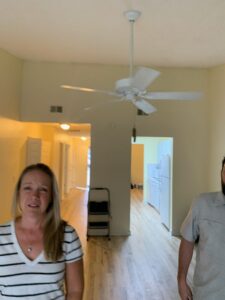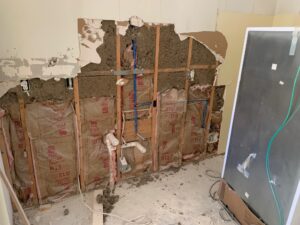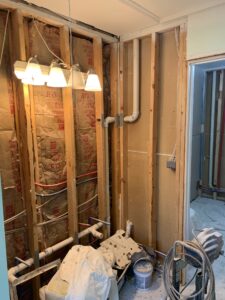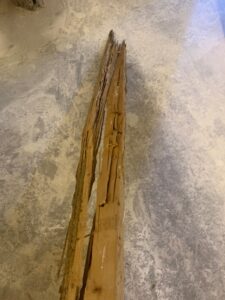A few weeks ago, I purchased our newest dump … AKA, our investment property, in Charleston, SC. We get asked a lot about getting into the flips and the investment game, so I’ll share in real-time some key tips from from my experiences and, yes, even my miscalculations. In this multi-part series, I will navigate you through:
PART 1: Miscalculations. Every investor miscalculates the money and time it takes for renovations. Unfortunately, most new investors discover their miscalculations after they’ve closed on the property.
For perspective, I’m going to consistently reference our current renovation in progress so you have real-time info on the steps I’m taking. Here are some pictures for your viewing pleasure! This one is a full gut job, so it will serve as a GREAT example of getting down to the nitty gritty on every component of a property …





My wife’s face says it all! Used syringes in the bathroom, mold, termite damage, cigarette smoke, and plumbing disasters. Therein lies the opportunity for the right price, but the key word is RIGHT PRICE. We snapped this one up well under market value and we will likely hold this one as an AirBnB due to the high rental rates (proximity to DT Charleston and Folly Beach).
Look Deeper!
Most newbies only see the cosmetic updates when trying to estimate the dollars it would take to bring a home back to life. However, there’s so much more to the picture than simply adding fresh paint or some new flooring. When inspecting, always look for clues! For example, I noticed mold behind the bathroom vanity during our inspection (along with Q-Tips, yum). For this one issue, mold means you’ll need a mold remediation company, a plumber to first disconnect the water lines, then repair leaks, a drywall guy, someone to haul off the old vanity, and a painter.



I want you to start thinking about the chain of events for every repair. Each repair can involve several contractors, which means it will take more money and time than you may have originally budgeted. Those need to be factored into your preliminary estimates.
“They’re called investment properties for a reason.” – Mike Wistrick
Ready to begin? In Part 1, I’ll walk you through the first 3 key steps before closing on an investment property.
Step 1: Geographic Location – If you’re buying a beach or mountain property, that requires different knowledge than buying locally. A strong local Realtor does the heavy lifting on information gathering – which is Step 1 in protecting your money. For our Charleston purchase, we hired Nic Spalviero, who was our guide and boots on the ground while we were here in Atlanta (we can help vet good agents on your behalf in other states):
Step 2: Estimate Waiting Game – Did you know most novice investors burn the first 30 days after closing waiting on renovation estimates? Turns out contractors operate on their timeline and current workload, not yours. They tend to take quite a while to first come out to the property and then actually deliver a written quote. When renovating, you’ll need estimates from from multiple pros, so don’t get caught waiting! Be proactive in scheduling – time is money, and that first mortgage payment will roll around faster than you think. Now, let’s get your head thinking in the right direction:
Step 3: The Rule of 3 or 4 – When getting estimates, I personally get at least three or four per job. You need multiple estimates because some will flake out and some will be too expensive. Collectively, multiple estimates will calibrate if you’re getting a good price. It’s time consuming, but don’t be lazy and take the first bid.
Why 3-4?
Here are real-time estimate ranges for my 1100 sq ft Charleston townhome:
See why you need multiples? Contractors are either great or they are a scam. Vet them by asking for pictures, references, license and reviews.
To sum up Part 1, go the extra mile on your home inspection. Start thinking about the chain of contractors needed for each repair or update. Get 3-4 estimates for each job.
Stay tuned for Part 2. I’ll walk you through how to estimate projects, like showers, kitchen cabinets, countertops, etc. Knowing these crucial tips will prevent you from losing thousands of dollars.
My first “investment” horror story, I’ll sum it up here…
I was 25 years old (before I got my real estate license) and bought a fixer-upper in the roughest part of ATL. I was swindled by the listing agent who claimed they were planning massive rejuvenation projects, luxury golf courses, etc. in the area. The appraiser, lender AND home inspector were all in on it as well. After closing, we discovered the structure was caving in, along with every other plumbing, termite, and HVAC issue. My windows were consistently broken from vandalism and the literal AC unit was stolen (it was caged in, by the way). After sinking more than $40,000 (a lot of cash for a 25 yr old bartender at the time) with a joke of a contractor (another huge mistake), the home was foreclosed because nobody would insure it. I was left dead broke with collections threatening me and my family, with no property to show for it. Disaster at the time, but incredible training for my future. Now you know why I’m bald!
My dad gave the best advice. He said “Son, get your real estate license and make sure this doesn’t happen to anyone you help.” And 21 years later, here I am, writing this in hopes to make a first-time investor’s path a little easier.